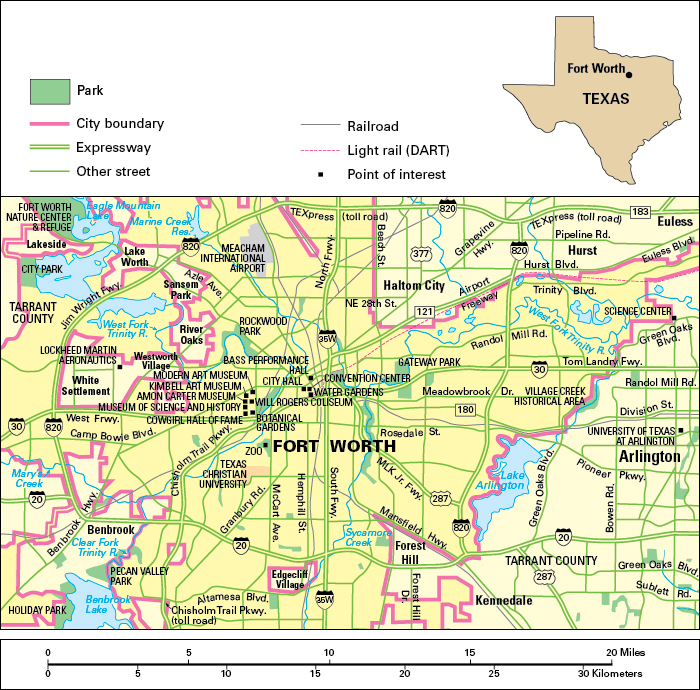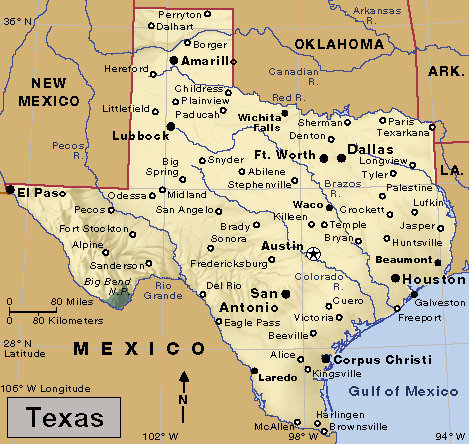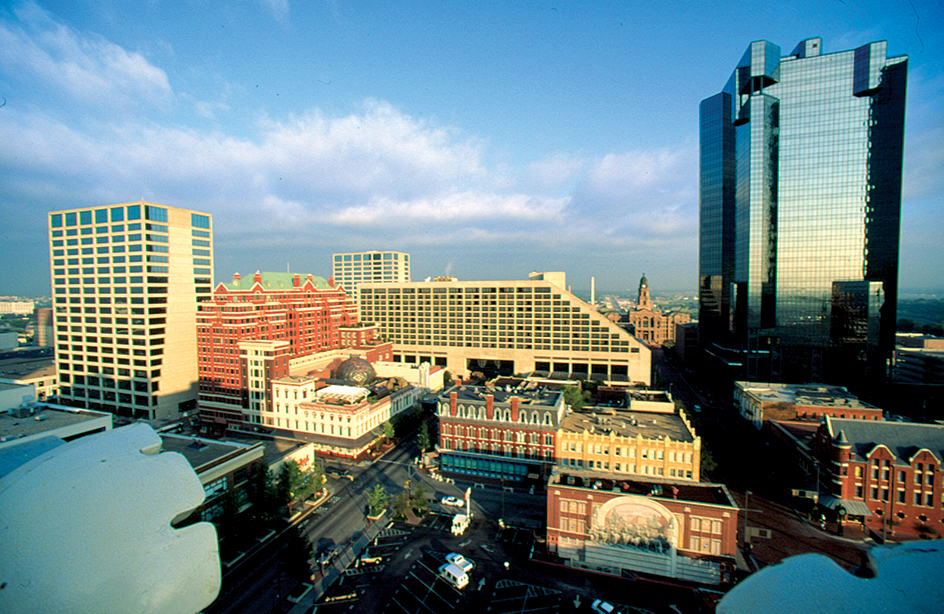Fort Worth, Texas (pop. 918,915), is a major industrial city and one of the nation’s chief aircraft producers. It is a leading Southwestern market for oil and grain. Fort Worth lies about 30 miles (50 kilometers) west of Dallas in north-central Texas.

Major Ripley A. Arnold founded Fort Worth in 1849 as an Army post to protect settlers from Indian attacks. The post was named for Major General William J. Worth, a hero of the Mexican War (1846-1848). Fort Worth is still occasionally called “Cowtown.” The city got this early nickname because of its history as a cattle-marketing center.
The city
occupies 356 square miles (924 square kilometers) in the center of Tarrant County. Fort Worth is part of the Dallas-Fort Worth-Arlington metropolitan area. This area has a population of 7,637,387 and covers 9,007 square miles (23,329 square kilometers). The city is also part of the Fort Worth-Arlington-Grapevine metropolitan division. The division covers Johnson, Parker, Tarrant, and Wise counties and has a population of 2,507,421.
Fort Worth’s main business district lies on the south bank of the Trinity River, which runs through the center of the city. The tallest buildings in Fort Worth include Bank of America Tower, Burnett Plaza, and 777 Main (formerly Carter Burgess Plaza). At the southeast end of the downtown area, the Fort Worth Convention Center covers 14 city blocks between Houston and Commerce streets. South of the Convention Center are the Fort Worth Water Gardens, designed by architect Philip Johnson.

About 35 percent of the city’s people are Hispanic Americans. African Americans make up about 20 percent of the population.
Economy
of Fort Worth is based on tourism, trade, transportation, and manufacturing. Major attractions include downtown, the Stockyards, the Cultural District, and the zoo. Fort Worth serves the Southwest as a center for finance and wholesale trade. The airline industry is also an important employer in the Fort Worth area.
The city is home to hundreds of manufacturing firms. Fort Worth’s largest industries make airplanes, helicopters, and electronic equipment. Other products include food products, mobile homes, and oil-well equipment. The city is also one of the region’s leading grain-milling and storage centers. The Naval Air Station Joint Reserve Base Fort Worth is a major employer in the city.

Fort Worth lies in the center of a rich oil-producing region, and dozens of oil companies have offices in the city. Numerous insurance firms have their headquarters in Fort Worth. The city ranks as a major wholesale outlet for the Southwest. It is served by freight and passenger rail lines, and bus and truck lines. Two interstate highways intersect in the downtown area. The Dallas-Fort Worth International Airport lies about midway between the two cities.
Education and cultural life.
Fort Worth is the home of the Southwestern Baptist Theological Seminary, Texas Christian University, Texas Wesleyan University, and the University of North Texas Health Science Center. A campus of the University of Texas is in nearby Arlington. The Fort Worth Independent School District manages and operates the city’s public schools, supervised by an elected Board of Education Trustees. Fort Worth also has a number of private schools, many of which are supported by religious groups. The Fort Worth Star-Telegram is the only daily newspaper in Fort Worth.
Fort Worth’s symphony orchestra and ballet and opera companies use the downtown Bass Performance Hall. Many people enjoy summer musicals at the Casa Mañana. The Fort Worth Stock Show & Rodeo is one of the nation’s largest livestock shows. The city is home to minor league baseball and hockey teams. The Texas Rangers of the American League play their home baseball games in Arlington. The Texas Motor Speedway, north of Fort Worth, features automobile races.
A number of Fort Worth’s museums are in the city’s Cultural District, which lies near the downtown area. The district is home to the Modern Art Museum of Fort Worth, the Kimbell Art Museum, and the Amon Carter Museum of American Art. Other museums in the district include the Fort Worth Museum of Science and History and the National Cowgirl Museum and Hall of Fame, which honors pioneering women of the American West.
In Forest Park, 3 miles (5 kilometers) west of downtown, the Fort Worth Zoo has hundreds of kinds of animals. The park also has the actual homes of early Fort Worth settlers in a log cabin village. The nearby Botanic Garden, the oldest in Texas, features over 2,500 native and exotic plants.
Government.
Fort Worth has a council-manager form of government. Voters elect the mayor and eight council members to two-year terms. The council employs a city manager as the administrative head of the government. The city manager carries out policies established by the council, prepares the budget, and appoints and dismisses department heads. The government gets most of its income from property and sales taxes.
History.
On June 6, 1849, Major Ripley A. Arnold established an Army post called Fort Worth to protect settlers from attacks by Indians. The soldiers left in 1853, and many settlers moved into the Army buildings. Fort Worth became the county seat of Tarrant County in 1860. During the 1860’s and 1870’s, the people traded with cowboys driving cattle to markets in Kansas. Fort Worth was incorporated as a city in 1873.
In 1876, the Texas and Pacific Railway reached Fort Worth, allowing cattle to be shipped directly from the city. As the railroad and cattle industries developed, the city’s population grew from 500 in 1870 to 26,688 in 1900.
In 1902, the Swift and Armour companies built large meat-packing plants in Fort Worth. The meat industry helped Fort Worth’s population reach 73,312 by 1910. The discovery of several oil fields in West Texas about 1915 brought more people to Fort Worth. By 1930, the city’s population had climbed to 163,447. The Great Depression almost stopped Fort Worth’s growth during the 1930’s. Only 14,000 new residents settled there between 1930 and 1940.
During World War II (1939-1945), Fort Worth became a center for the manufacture of airplanes, helicopters, and other military products. Jobs created by defense industries caused a sharp population rise during and after the war. The city had 356,268 people by 1960.
Fort Worth’s growth slowed during the 1960’s, and its population declined in the 1970’s as many people moved to the suburbs. Unemployment in the defense and oil industries and the closure of meat-packing plants contributed to the population slowdown and decline.
Fort Worth’s development has been affected by a traditional rivalry with Dallas, which has a larger population and a stronger economy. Efforts toward greater cooperation led to construction of the Dallas-Fort Worth International Airport, which opened in 1974.
To help slow and offset the movement of people and trade away from the city into the suburbs, city leaders began a major downtown revitalization program in the late 1970’s. New office towers were built, and a group of small historic buildings was restored, creating a shopping and entertainment area called Sundance Square.
In the 1980’s, Fort Worth’s population began to grow, largely because of an increase in national defense spending in the area. The city still depends heavily on jobs in defense plants, even though its economy has broadened. Fort Worth grew dramatically during the early 2000’s. Between 2000 and 2020, the city added more than 375,000 people.
